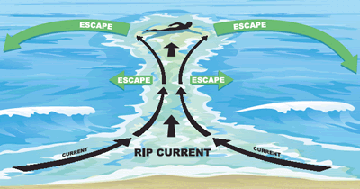270812 rip-sign4-27-sm.GIF

Illustration showing how to escape a rip current. Credit: National Oceanic and Atmospheric Administration
It can happen to even the strongest swimmers. You’re splashing in the surf, enjoying the waves and sunshine, when you notice that you’re farther from shore than you should be. And as you tread water for a moment, you realize you’re being pushed out to sea. You’re a victim of something that’s found along almost every beach: a rip current.Rip currents form as water pushed ashore by wind and waves moves back out to sea. It moves through cuts in sandbars or along other lines that form swift, narrow channels.
Rip currents kill more than 100 swimmers on American beaches every year. Yet few beachgoers are aware of the danger signs. A recent study by researchers from two universities — West Florida and Texas A&M — found that more than half of beachgoers said they knew what to look for. Yet when they were asked to identify rip currents on photographs, or to draw what a rip current looks like, most failed.
Most pointed to the heaviest surf as the danger zone, but that’s not usually the case. Instead, the rip current tends to be calmer than the surrounding water. It’s often a different color from the water around it, and objects floating in the current are moving away from shore.
If you get caught in one, experts say you shouldn’t try to swim directly toward shore. Instead, note which way the current is carrying you and swim at a right angle to that direction to “break the grip of the rip.” Most rip currents aren’t very wide, so it shouldn’t take long to escape — and head safely back to shore.
This episode of Science & the Sea was made possible by Texas Sea Grant.

